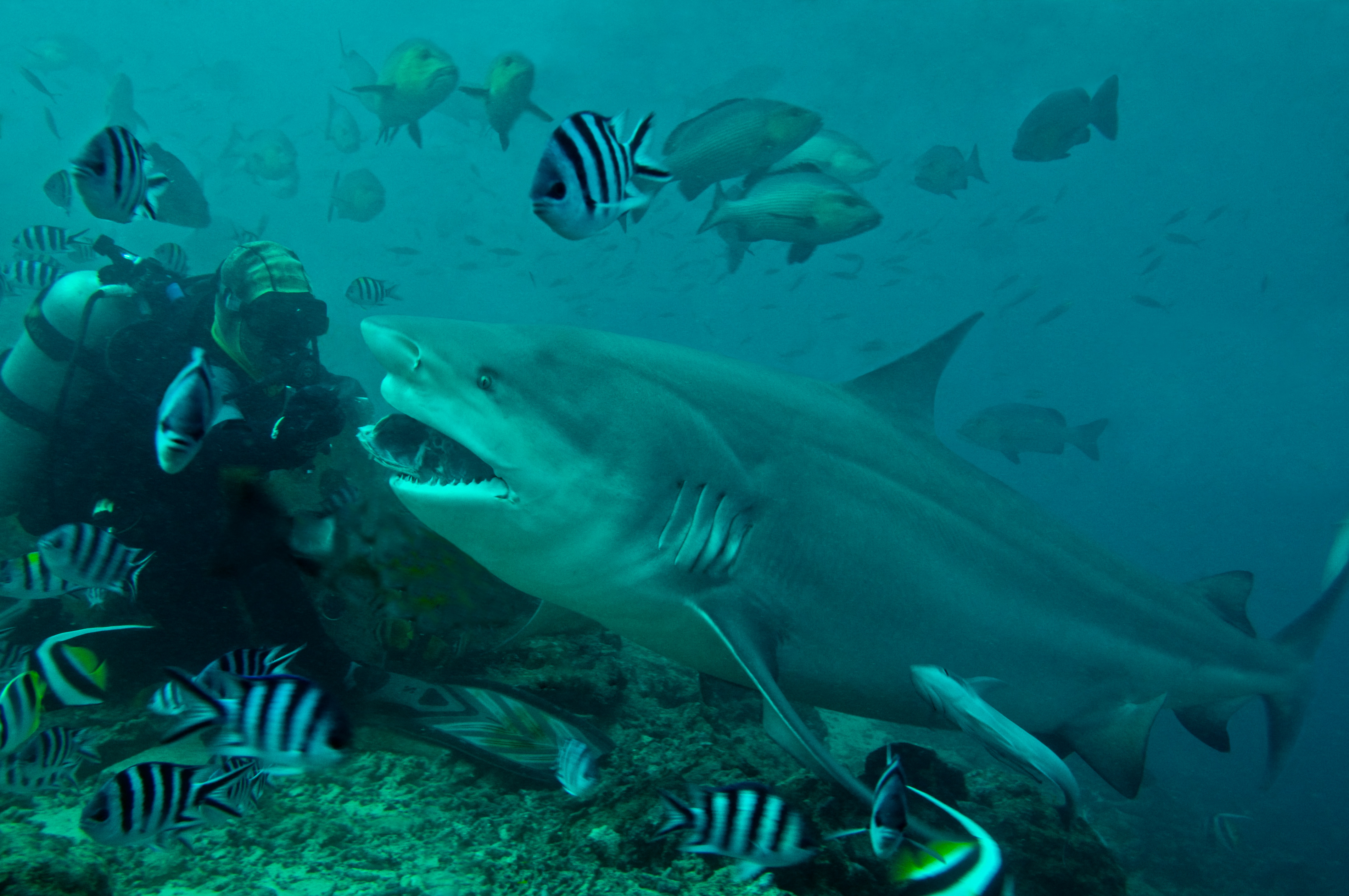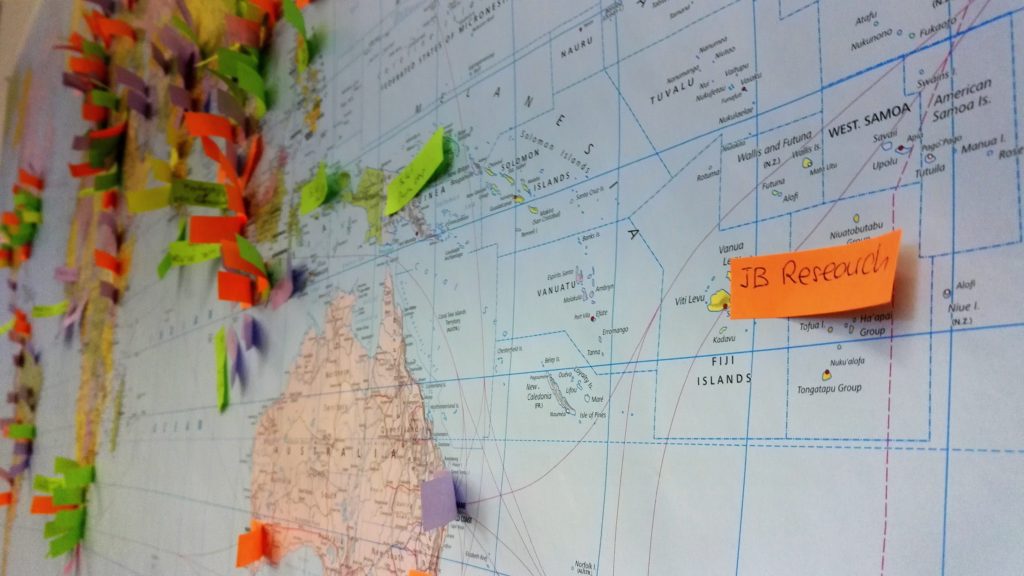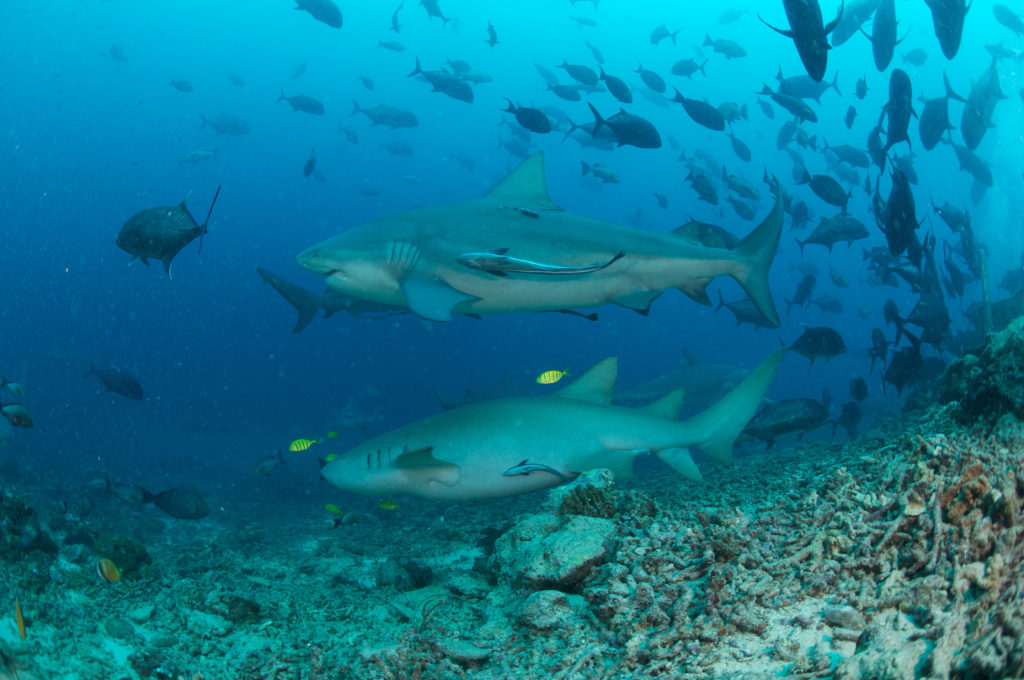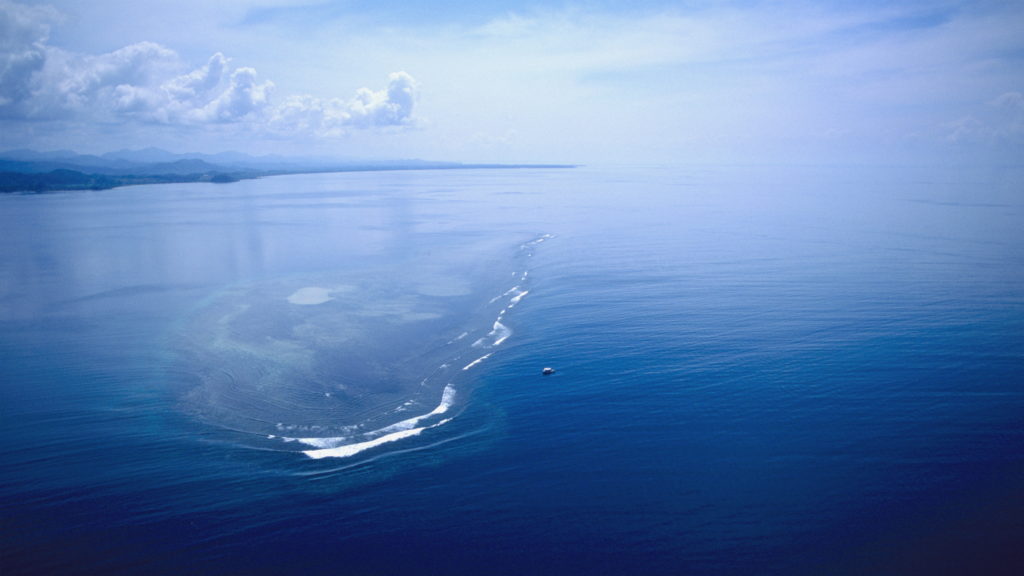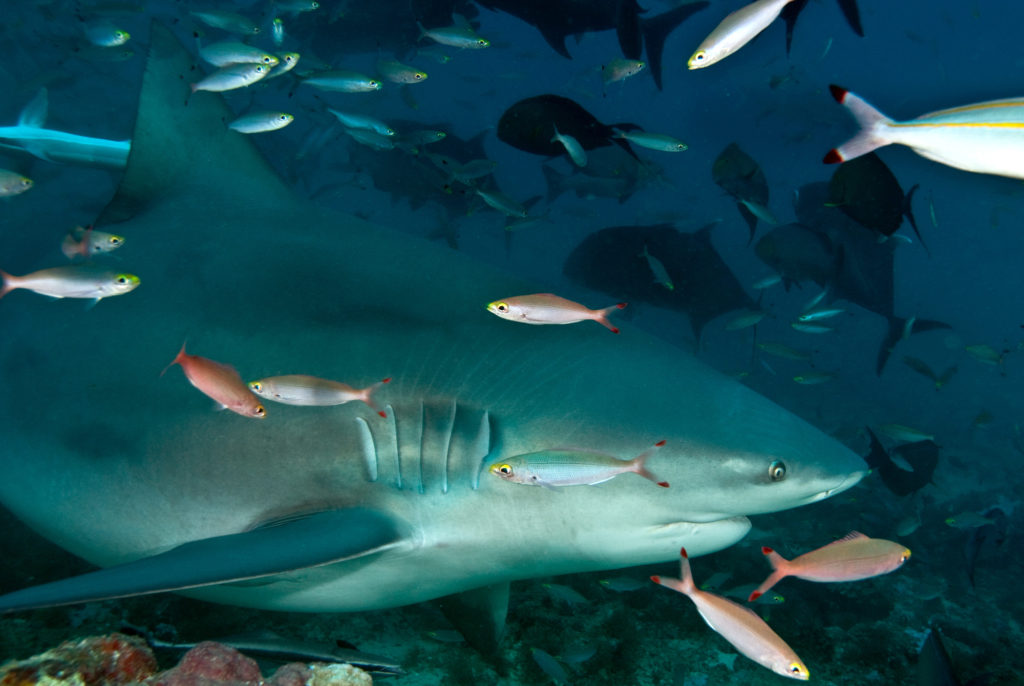At our ETH Global team retreat in 2015, we kicked off the day with a playful exercise: on the table was a world map. Each team member then placed Post-it Notes on the countries or cities where the ETH Global team has been active over the past few years. For example, where we organized outreach activities, worked together with partner institutions, or where we had other international collaborations or connections. The result was a world map speckled with colorful Post-it Notes. As you would expect, there were dense Post-it clouds on the east and west coasts of North America, in Europe, and on many Asian countries, even in places like South Africa. Then way out in the middle of the South Pacific was one single, lonely Post-it labeled, “JB Research.”
A lonely Post-it on Fiji
I am “JB” – Jürg Brunnschweiler – and the Post-it Note is on Fiji a country where I still do a little bit of work from time to time as an independent researcher. You may be wondering how a Swiss biologist washed up on a beach in Fiji, and why he keeps going back. I did my PhD thesis, at the University of Zurich, on the behavior and ecology of free-ranging sharks. One of the species that I focus on in my research is the bull shark. This is a large coastal shark that often comes close to shore, even in urbanized regions, for example in Florida or on the east coast of Australia. The bull shark is a special shark because it can live in both fresh and salt water for long periods. While adult bull sharks typically thrive in marine habitats, juveniles spend the first years of their lives in fresh water rivers and estuaries. While shark biologists have a good understanding of how juveniles use their fresh water habitats, much less is known about the behavior of adult bull sharks in the ocean.
Migrants from landlocked Switzerland
One major challenge when working with wild sharks is accessibility. In order to study the behavior of free-ranging sharks, one needs to either observe them directly or equip them with different types of transmitters in order to study their movements. Fiji and in particular Shark Reef, a small reef patch on the southern coast of Viti Levu, Fiji’s main island, offered everything I needed when I first went there in 2003. The visit to Fiji was a “plan B” after a major hurricane destroyed my original field site in the Bahamas, where I first started to study the behavior of adult bull sharks. What I found on Shark Reef was a population of large bull sharks to which I had exclusive access via a shark dive operator. At about the same time I came to Fiji, another migrant from Switzerland set foot on the island to work on a shark tourism and conservation project. We teamed up and over the years created the Shark Reef Marine Reserve (SRMR) an example of how shark tourism can be an effective strategy for contributing to apex predator conservation.
Shark Reef Marine Reserve – Fiji’s first National Marine Park
The Shark Reef Marine Reserve is a tourism project designed to protect a small reef patch and its fauna while preserving the livelihood of local communities. The primary attraction at the SRMR is a shark-feeding scuba dive during which divers might encounter up to eight species of shark, including bull sharks. Since 2002 villagers, who traditionally own the fishing rights on Shark Reef, have granted exclusive access to the no-take zone to just one dive operator. In return, they receive compensation through a marine park levy paid by each visitor to the reef. In November 2014, the government declared the SRMR Fiji’s first National Marine Park—a designation specifically intended to protect sharks. The tourism operator, under the authority of the government, manages the SRMR as a successful public-private partnership. It has proven scientifically valuable as a platform to collect data on shark species composition and abundance, as well as residency and movements in and out of the protected area. Longitudinal data of this sort is valuable for quantifying protected area coverage of predator movements, and may beneficial for creating a case for expansion of the marine protected area boundaries.
Hand-feeding sharks
Apart from the more general conservation aspect, an important area of study for me has been to monitor and quantify the effects of food provisioning on the behavior of adult bull sharks. What we found over the years was that at the Shark Reef Marine Reserve, the impact of provisioning tourism on sharks seems to be relatively minimal; research suggests bull sharks gather in the SRMR even when feeding is not taking place, and that individual animals exhibit varying degrees of fidelity to the feeding site. The response to the food on offer varies between bull shark individuals. Individuals consume different amounts of food and not all individuals that are attracted to the site actually feed. Diver observation and tracking data suggest that bull sharks may leave the SRMR for months at a time, particularly towards the end of each calendar year. These departures relate to reproductive activities, which suggests habituation is not severely disrupting key life history events for provisioned sharks. The full list of research published from the SRMR can be found here.
Protecting juvenile bull sharks
Today we have a good understanding of the behavior of the adult bull sharks encountered at the SRMR, as well as, how provisioning tourism affects them. Therefore, we have shifted the focus to the juveniles in the rivers and their connection to the adult population in the Shark Reef Marine Reserve. For example, it is one (good) thing to protect the adult population, but if we do not protect juvenile sharks in their nursery grounds, eventually bull shark numbers in coastal waters will go down. In Fiji, like in any other country, the anthropogenic pressures on riverine, estuarine and coastal habitats are real and increasing. In order to protect juvenile bull sharks in their habitats, we need to know more about these sites. To learn more, we have started to equip pregnant bull sharks with so-called acoustic transmitters at the SRMR and placed receivers that can detect such tagged sharks in all of Fiji’s major rivers. This means that we are able to track pregnant females as they move into the habitats where they give birth. At the same time, we do shark-fishing surveys in the major rivers close to the SRMR. When we catch juvenile bull sharks, we take tissue samples for genetic and kinship analyses, and equip the sharks with acoustic transmitters. This allows us to monitor their movements in the river and more importantly, detect them when they join the adult population at the SRMR in a few years.
When I started doing fieldwork in Fiji 15 years ago, shark research was not at all on the map in this remote island state. I find it remarkable that just a handful of people from far away and landlocked country like Switzerland were instrumental in achieving this feat. In addition to my research – and nowadays I am only able to spend a few days a year in Fiji, Kerstin Glaus did her Master’s thesis on Fiji’s artisanal shark fisheries and has since moved to Fiji. She currently conducts research for her doctoral studies at the University of the South Pacific. In 2016, the first student from ETH Zurich joined the project, Franziska Genter from D-USYS. Franziska spent several months in Fiji conducting the first shark fishing survey in the Singatoka river. Recently, Pascal Flükiger has continued this important work in the Singatoka river. You can read his blog post from Fiji here next week.
Einstein Episodes
Please watch the above mentioned Einstein Episodes here (part 1) and here (part 2).
By Jürg Brunnschweiler
Jürg Brunnschweiler got his PhD in Biology at the University of Zurich. He is now head of ETH Global, the international office of ETH Zurich. A documentation about his research project at the Shark Reef Marine Reserve will be aired on Swiss television’s science program “Einstein” in April.

